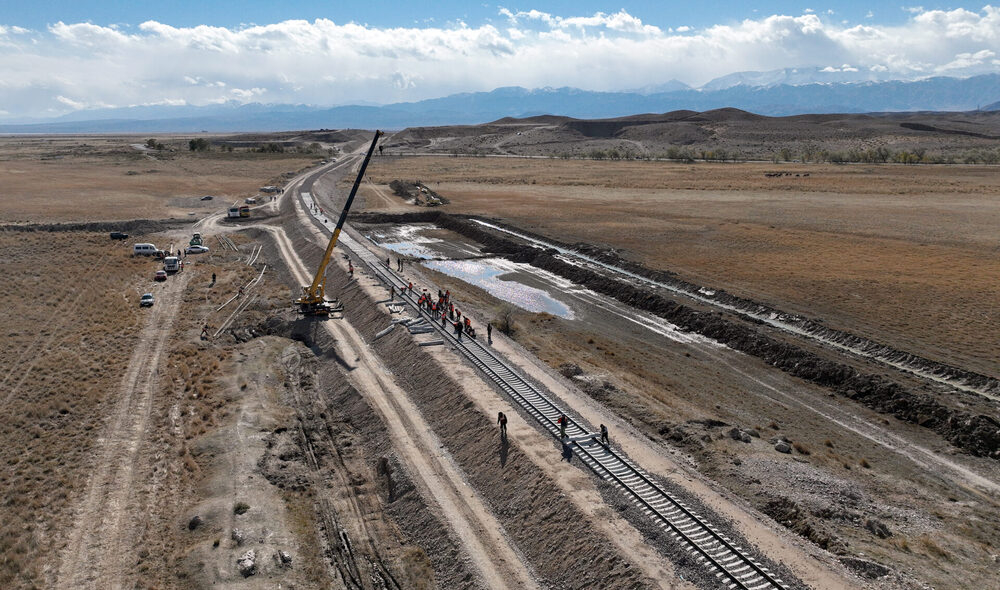- ВКонтакте
- РћРТвЂВВВВВВВВнокласснРСвЂВВВВВВВВРєРСвЂВВВВВВВВ
The China-Kyrgyzstan-Uzbekistan (CKU) railway plans are back on track. On June 6, representatives from the three countries signed off on the project in Beijing, setting in motion a key transportation project that has been in talks for the last 27 years, and was more recently included in China’s Belt and Road Initiative (BRI). According to the agreement, construction will begin in October.
What is the CKU? The construction of the CKU railway was first proposed by the Transport Corridor Europe-Caucasus-Asia Initiative (TRACECA) in 1997 but has remained in talks for 27 years due to the complicated nature of the project.
The railway will begin in Kashgar, then enter Kyrgyzstan through the Torugart pass, continuing to Kazarman and back down to Jalal-Abad. The final destination will be Andijan in Uzbekistan, connecting with existing rail routes.
In connecting Kashgar to Andijan, the CKU railway would provide an alternative trade route between China and Uzbekistan. Instead of passing through Kazakhstan via Khorgos, the CKU will save around 900 kilometers to reach Iran and the Middle East from Kashgar.
The proposed route will further integrate Kyrgyzstan into Central Asian trade routes and potentially open new transport avenues to European and Gulf countries.
“[Central Asian countries] want to develop more routes interconnecting Central Asia and external markets to lessen their economic dependence on Russia,” Oyuna Baldakova, a research associate at King’s College London focusing on China-Central Asia relations, told Vlast.
Why the Delay? According to Omirbek Hanayi from the Eurasian Research Institute in Kazakhstan, the revolutions of 2005, 2010, and 2020 have brought political instability in Kyrgyzstan, which have stalled negotiations.
The different rail gauges between China and post-Soviet countries have historically made negotiations more difficult. China uses the world standard gauge width of 1,455 millimeters. Kyrgyzstan and Uzbekistan, on the other hand, use a gauge width of 1,520 millimeters. It is unclear which device could be used to bridge the difference for the CKU railway.
Kyrgyzstan’s terrain also poses serious challenges. The plan for the railway is to travel through 81 new bridges and 41 tunnels, across the country’s mountainous territory.
Optimism vs Concern Kyrgyzstan’s Head of the Cabinet of Ministers Akylbek Japarov has come out with stark optimism after signing the agreement for the project, stating that the CKU will bring Kyrgyzstan into the “world market,” and transform “Kyrgyzstan into a major trade and industrial hub.” Chinese President Xi Jinping was optimistic from a different angle, highlighting that the CKU “demonstrates to the international community the firm determination of the three countries to join hands to promote cooperation and seek common development.”
However, concerns remain over the disconnected nature of Kyrgyzstan’s rail routes. “It would be wonderful for Kyrgyzstan and the Kyrgyz people to connect Bishkek [directly] to Kashgar and the Ferghana Valley, but that’s not going to happen,” Tristan Kenderdine, research director at Future Risk, told Vlast.
The Ala-Too mountains in central Kyrgyzstan, in fact, pose a permanent obstacle to the development of infrastructure projects.
Who’s Paying and When Will It Start? According to 24.kg, China will cover 51% of the total cost, while Kyrgyzstan and Uzbekistan will each bear 24.5%.
Answering questions from the Parliament on June 18, the director of Kyrgyz Temir Zholu, the national railway company, said that Kyrgyzstan will finance construction through loans provided by Chinese banks, Kloop reported.
Until June 18, financing the railway posed one of the biggest negotiation setbacks, but with recent agreements, construction looks to kick off in October.
“For years, there was no agreement in terms of the finances. Before allocating funding on projects from international institutions like [China’s EXIM Bank], Chinese institutions assess risks, and financing the section of the railway in Kyrgyzstan presented financial risks,” Frank Maracchione, PhD researcher at the University of Sheffield, told Vlast.
In a piece for The Diplomat last year, Nargiza Muratalieva argued that Kyrgyzstan’s external debt was just under $4 billion, with 43% owed to China’s EXIM bank. This figure makes up around 40% of Kyrgyzstan’s GDP, highlighting concerns from many analysts over the government’s ability to repay its debts.
[Correction: a quote in the 9th paragraph was misattributed to Kyrgyzstan's President Sadyr Japarov. It was in fact by the Head of the Cabinet of Ministers, Akylbek Japarov]
Andrew Gundal is a contributing writer on Central Asian affairs.
Поддержите журналистику, которой доверяют.








